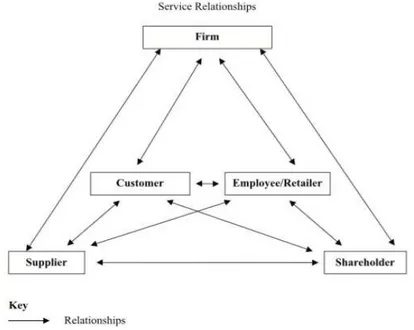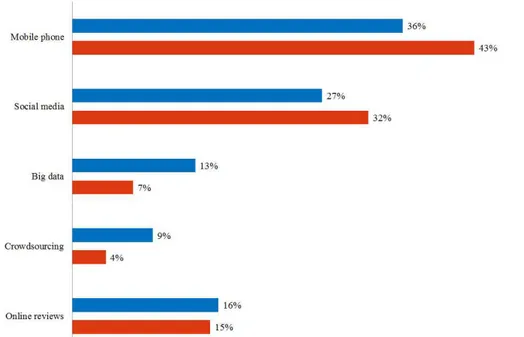Dan POPESCU1 Livia TOANCĂ2 Cristina STATE3
Abstract
Service enterprises constitute significant drivers of growth for developed countries as well as countries in development. The global economy in combination with the fast paced development of technology in the digital era create opportunities for companies that realize the importance of the service-technology convergence phenomenon, also known as the service economy 3.0.
In the case of the Romanian economy, SMEs and the service sector contribute significantly to
the country’s economic growth and our study aims to uncover opportunities for Romanian
service SMEs to further their chances of succeeding on the global service market through adoption of digital technologies.
We find that it is of utmost importance for Romanian service SMEs to bridge the digital divide through furthering their knowledge of network effects and digital ecosystems that can ultimately result in developing core competencies that help them remain relevant on the global services market.
Keywords: service economy, knowledge economy, digital transformation, small and medium size enterprises
JEL CLASSIFICATION: M10, M11, M19.
INTRODUCTION
The service sector took centre stage in the post-industrial economy as the next sector of rapid growth as the relative importance of manufacturing reduced, making way for new, and intangible means of adding value for customers and consumers. Chang (2015) expands on the evolution of the service economy, breaking it into different historical stages: Service Economy 1.0, Service Economy 2.0 and Service Economy 3.0 and underlining the progressive importance of technology in the evolution of the service sector (Table 1). The authors explain the progression from service as a technology adopter in the 1960’s, when the emphasis was less on innovation and more on supplier-driven services to the rise of knowledge intensive business services (KIBS) in the 1980s and ultimately, after 2010, to the emergence of technology-enabled services that constitutes a full shift toward an economy of service characterized by the convergence of technology and service.
1
Bucharest University of Economic Studies, Romania, dan.popescu@man.ase.ro
Table 1 The evolution of service economy
Source: Chang, Miles, & Hung, 2014
The service sector is gaining increased importance in the global economy and is most likely to transcend borders and drive innovation. As the global market becomes more and more competitive, a customer-centric approach to the business model of firms in general, and of service firms in particular gains more importance. Service organizations make efforts to obtain insights about the customers’ current and future needs in order to remain relevant on the market. There is a strong need for companies to re-invent themselves and develop core competencies that will take them to the next stage of business growth.
Successful service companies develop partnerships with various stakeholders (Kandampully and Duddy, 1999), creating a network that sustains growth and innovation. Horizontal strategy is, according to Porter (1985) a corporate strategy that will allow companies that seek competitive advantage to develop core competencies that are hard to imitate therefore creating long term value for the organization.
Figure 1. Service relationships: Innovation as the core competency of a service organisation: the role of technology, knowledge and networks
Figure 2. Core competency in services: Innovation as the core competency of a service organisation: the role of technology, knowledge and networks
Source: Kandampully, 2002
Many authors (Kandampully, 2002; Chang, Miles & Hung, 2014; Christensen, 2015; Palfrey & Gasser, 2013) emphasize the importance of technology in the context of service organizations seeking to innovate and gain relevant core competencies. Technology contributes substantially to enhancing knowledge, the flow of information and to solidifying relationships (Figure 2). Furthermore, the employment of an integrative relationship marketing system requires that any transaction with customers creates valuable information that will be stored in a central database and utilized to create long term relationships (Shani & Chalasani, 2013).
1. RESEARCH METHODOLOGY
The research, conducted between June and July 2016, started with the distribution of a questionnaire by email to over 160,000 small and medium size enterprises in Romania. After analyzing the results by industry and extracting responses from the SMEs that operate in the service industry as well as the IT&C industry, we sought to identify the degree of adoption and integration of digital advancements in their operations and to highlight any differences between the digitalization of Romanian IT&C small and medium enterprises and those who offer other services.
The service sector constituted 28.1% of the Romanian GDP in quarter 4 of 2015 whereas the IT&C sector accounted for 5.7% of the Romanian GDP (source: Romanian National Institute of Statistics, 2016), which indicates that the service sector is of utmost importance for the
country’s economic development.
2. RESULTS
Figure 3. Rationnale for investing in digital, comparison between Romanian IT&C SMEs and Romanian service SMEs
Source: Questionnaire Results
We noticed that 62% of Romanian IT SMEs state that investing in digital is part of the
company’s strategy, compared to only 38% of Romanian service small and medium sized
companies (Figure 4).
Figure 4. Utilization of databases in order to personalize offers, comparison between Romanian IT&C SMEs and Romanian service SMEs
Source: Questionnaire Results
development of personalized offers, as opposed to 14% of Romanian IT&C SMEs (Figure 5).
Figure 5. Knowledge and usage of terminals that customers and clients use, comparison between Romanian IT&C SMEs and Romanian service SMEs
Source: Questionnaire Results
Clients and customers often provide data through terminals that service and IT&C companies can utilize and also interconnect their systems for better integration. When asked if they know what these terminals are and if they are or intend to interconnect, 39% of Romanian service SMEs indicated the fact that they are not interested in finding out what the terminals that the clients and consumers use are, as opposed to 15% of Romanian IT&C SMEs that expressed the same sentiment. 48% of Romanian IT&C SMEs are connected to the terminals and only
20% of Romanian service SMEs indicated that they are currently connected to their clients’
and consumers’ terminals (Figure 6).
Figure 6. Types of websites, comparison between Romanian IT&C SMEs and Romanian service SMEs
When asked about whether or not they have a website, 52% of Romanian SMEs indicated that they have a presentation website but only 14% attested to the fact that the website is mobile enabled. Certainly having a presentation site on the internet is an important first step but with the emergence of mobile internet users having a mobile enabled website is necessary (Figure 7).
Figure 7. Utilization of digital technology, comparison between Romanian IT&C SMEs and Romanian service SMEs
Source: Questionnaire Results
Utilization of technology by Romanian service SMEs in comparison with Romanian IT&C SMEs is relatively high, with 43% of service SMEs utilizing the mobile phone, 32% of service companies using social media compared to 27% of IT&C companies and 15% of service enterprises using online reviews compared to IT&C enterprises. Where we notice a lower utilization of digital technology by Romanian SMEs compared to IT&C SMEs is big data, where 7% of service companies use big data compared to 13% of IT&C companies and crowdsourcing, with a utilization percentage of 4% for service enterprise and of 9% for IT&C companies.
Figure 8. Utilization of mobile applications for gathering of data about clients and consumers, comparison between Romanian IT&C SMEs and Romanian service SMEs
Source:Questionnaire Results
The overall Utilization of mobile applications for gathering of data about clients and consumers by Romanian SMEs compared to Romanian IT&C SMEs is slightly lower, with 42% of service entities using mobile applications for this purpose compared to 47% of IT&C entitites (Figure 9).
Figure 9. Utilization of cloud technology, comparison between Romanian IT&C SMEs and Romanian service SMEs
The emergence of cloud technology facilitates access at affordable prices for SMEs to the types of technologies that would be out of reach a decade ago (Rogers, 2016). 22% of
Romanian service SMEs don’t utilize cloud technology as opposed to 7% of Romanian IT&C
SMEs, uncovering an opportunity for service companies.
3. CONCLUSIONS
In the context of the service economy 3.0, characterized by technology-service convergence, the adoption of digital technologies by the service sector becomes a sine qua non condition to the success of the service enterprises. Romanian SMEs have the potential to add to the growth
of the country’s economy and, since the service sector constitutes and important portion of the
Romanian GDP, it is now, more than ever, very important for service companies to integrate digital technology into their operations, enhancing the likelihood of success of the enterprises that recognize the importance of the realities of the digital era.
Our research compares the degree of digital technology adoption for Romanian service SMEs and Romanian IT&C SMEs, its goal being to uncover the opportunities in front of service SMEs to further their success.
We conclude that Romanian service SMEs have opportunities in terms of integrating the adoption of digital technologies with their company strategies, leveraging the power of integrative relationship marketing by increasing their utilization of customer and client databases, increasing their awareness and utilization of customer and client terminals, capitalizing on the myriad of data created by mobile applications, furthering their knodge and capitalizing on the power of big data and crowdsourcing as well and maximizing the utilization of cloud technology.
Connectivity and collaboration can also help service enterprises achieve better core competencies and allow service SMEs to maintain and constantly re-invent their competitive advantage and remain relevant to their target markets.
As the pace of change increases in the global economy we find increasingly important for service companies to expand their horizons and continuously evolve.
REFERENCES
Barrett, M., Davidson, E., Prabhu, J., & Vargo, S. (2015). „Service innovation in the digital
age: key contributions and future directions”, MIS Quarterly, 39(1): 135-154
Boisot, Y. & Max H. (1998). Knowledge assets: Securing competitive advantage in the information economy. OUP Oxford
Chang, Y., Miles, I. & Hung, S. (2014). „Introduction to special issue: Managing
technology-service convergence in Service Economy 3.0”, Technovation, 34(9): 499-504
Christensen, C. (2015). The Innovator's Dilemma: When New Technologies Cause Great Firms to Fail (Management of Innovation and Change). Boston: Harvard Business Review Press Kandampully, J & Duddy, R. (1999). „Competitive advantage throught anticipation, innovation
and relationships”, Management Decision, Vol. 37 (1)
Kandampully, J. (2002). „Innovation as the core competency of a service organisation: the role of technology, knowledge and networks”, European Journal of Innovation Management, 5(1): 18-26.
New York: Basic Books
Popescu, D., State, C. et al. (2012). „Managementul schimbării - condiţie a sustenabilităţii
organizaţionale în întreprinderile mici şi mijlocii din domeniul IT&C”, Amfiteatru
Economic Journal, XIV (32): 246-255
Rogers, D. (2016). The Digital Transformation Playbook: Rethink Your Business for the Digital Age. New York: Columbia University Press
Romanian National Institute of Statistics, 2016
Shani, D., & Chalasani, S. (2013). Exploiting niches using relationship marketing. Journal of Services Marketing, V(9)





